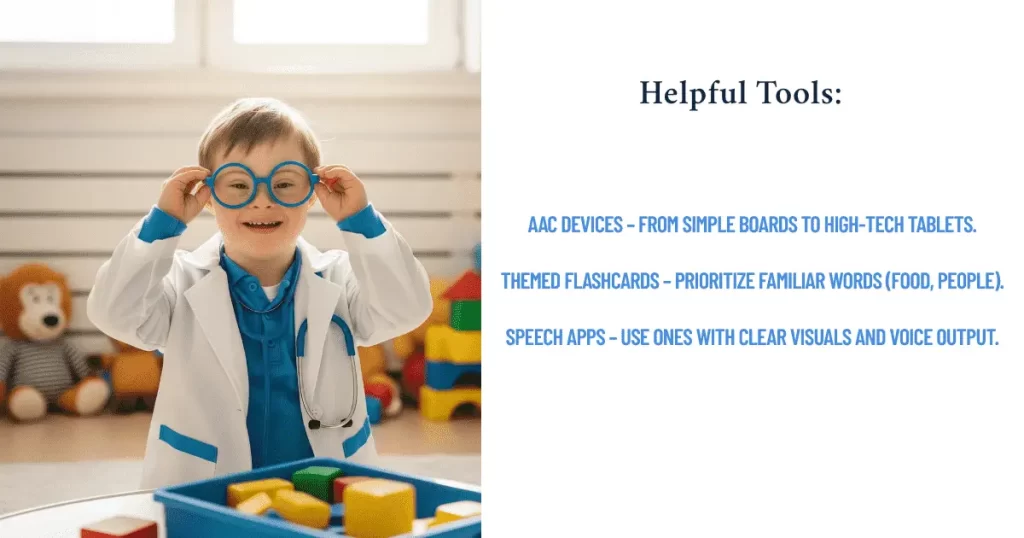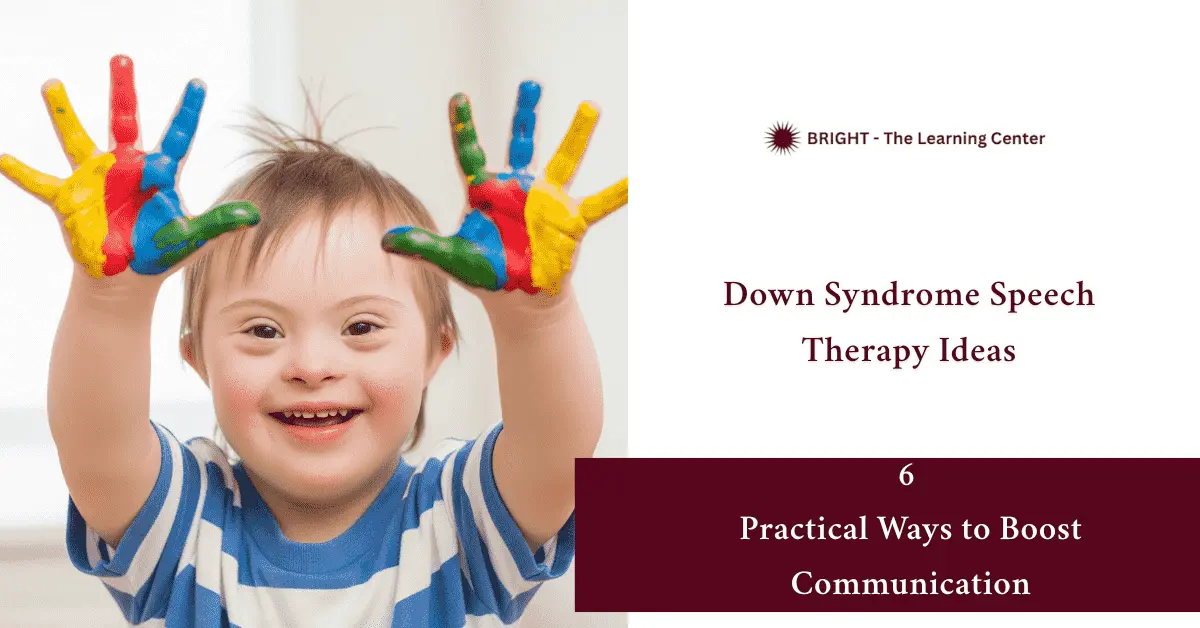Down syndrome speech therapy ideas offer practical tools to nurture communication from the very beginning. For parents and therapists alike, the goal isn’t perfection—it’s progress. Whether you're in the living room or therapy room, these ideas turn everyday interactions into powerful speech-building moments.
Table of Contents
Spot Early Signs with Confidence
Recognizing delays early is vital when exploring Down syndrome speech therapy ideas that truly make a difference. But what signs should raise concern?
By 12 months, children with Down syndrome may show less babbling or respond minimally to familiar phrases. By 18 months, fewer than 10 spoken words or little imitation can signal a delay. Even silence says something—especially when gestures or eye contact are limited.
| Age | Red Flags |
| 6–9 months | No babbling, weak eye contact |
| 12 months | No words, little response to name |
| 18 months | Few words, limited sound play |
| 24 months | No two-word combos, unclear speech |
Down syndrome speech therapy ideas rooted in early identification offer the best chance for success. A delay isn’t defeat—it’s a cue for support.
Set Milestones That Motivate
Down syndrome speech therapy ideas work best when paired with realistic, encouraging language milestones. Kids may develop speech more slowly, but each word gained is a win.
Why track milestones? Because they guide expectations and motivate effort—for both children and caregivers.
| Age Range | Language Indicators |
| 0–12 months | Eye contact, babbling, joint attention |
| 12–24 months | First words, sound imitation |
| 2–3 years | Two-word phrases, naming objects |
| 3–4 years | Short sentences, answering simple questions |
Tracking progress with flexible goals helps you adapt and celebrate every success. Down syndrome speech therapy ideas thrive when you follow the child’s pace, not a fixed chart.
Down Syndrome Speech Therapy Ideas That Work
Some Down syndrome speech therapy ideas are simple—and that’s their power. Repetition, purposeful vocabulary, and connection create the ideal foundation for growth.
Skip the flashcards and focus on real words that matter—“more,” “stop,” “help.” Use them in context. One word, many moments.
Effective Ideas to Try:
- Mirror Talk – Mimic sounds and faces together.
- Sound Play – Growl, moo, squeak—silly works.
- Echo Reading – Read a line, repeat it together.
- Choice Boards – Use pictures: “Juice or milk?”
- Picture Schedules – Connect visuals with daily routines.
Down syndrome speech therapy ideas succeed when speech is part of life, not a separate activity.
Use Home Activities That Build Speech Naturally
Daily routines hold powerful potential for Down syndrome speech therapy ideas that feel effortless. The kitchen, the bath, the toy shelf—all are speech zones.
Turn ordinary moments into opportunities. During meals: “Yum! Hot soup.” During bath: “Splash! Wash feet!” It’s not about quantity—it’s about connection.
At-Home Ideas to Try:
- Laundry Talk – “Blue sock. Daddy’s shirt.” Sort and speak.
- Toy Play – “Ball rolls. Bear sleeps.” Narrate naturally.
- Book Pointing – “Where’s the cat?” Wait for the point.
- Snack Choices – “Cracker or apple?” Let them decide.
- Mirror Time – Make silly faces: “Mmm,” “Ooo,” “Puh.”
When wrapped into play and routines, Down syndrome speech therapy ideas become second nature.

Pick the Right Tools for Support
The best tools don’t replace speech—they encourage it. Choose tools that empower children to express themselves. Great Down syndrome speech therapy ideas often include these supportive aids:
| Tool | Example Use |
| AAC Boards | Tap “drink” to request water |
| Flashcards | Show “apple” during snack time |
| Speech Apps | Tap icons, hear words spoken aloud |
Helpful Tools:
- AAC Devices – From simple boards to high-tech tablets.
- Themed Flashcards – Prioritize familiar words (food, people).
- Speech Apps – Use ones with clear visuals and voice output.
Down syndrome speech therapy ideas work better when children can communicate in more than one way—spoken, signed, or tapped.
Know When to Consult a Therapist
Sometimes, the best Down syndrome speech therapy ideas come from professionals. If your child isn’t using gestures, has under 20 words by age two, or seems puzzled by simple directions, it may be time to consult a pediatric speech-language pathologist.
Ready to take the next step? Learn what to expect in a Down syndrome speech therapy assessment and how it guides effective intervention.
When to Seek Help:
- Fewer than 20 words by age 2
- No two-word phrases by 30 months
- Limited response to questions or name
- Unclear or hard-to-understand speech
- Frequent frustration when trying to communicate
Speech therapists help unlock potential—not just pronunciation. If in doubt, don’t wait. Early help can change the course of communication.
Final Thought
Down syndrome speech therapy ideas aren’t complicated—they’re consistent. From naming socks to blowing bubbles, every interaction counts. Build speech through warmth, repetition, and real-life connection. And when in doubt, reach out. Your voice—paired with theirs—can open doors.
FAQs
How to do speech therapy for Down syndrome?
Speech therapy for Down syndrome starts with early recognition of speech delays and builds on consistent, everyday interactions. Use simple language, repeat key words, and incorporate gestures, signs, or AAC tools. Involve children in routines like mealtime and play to make speech natural and engaging.
What strategies work best with Down syndrome in speech therapy?
Effective strategies include:
- Repetition of functional words (e.g., “more,” “help”)
- Mirror play to mimic sounds and facial expressions
- Choice-making (e.g., “Juice or milk?”)
- Visual supports like picture schedules and flashcards
- Echo reading and simple storytelling
These strategies encourage both understanding and expression in familiar contexts.
How to help someone with Down syndrome communicate better?
Support communication by:
- Listening patiently and acknowledging all attempts to speak or gesture
- Encouraging turn-taking in games or conversation
- Modeling clear speech with slow, expressive language
- Using AAC tools when needed, such as picture boards or speech apps
- Celebrating small wins like new sounds or words
Above all, consistency, warmth, and positive reinforcement go a long way in helping individuals with Down syndrome communicate confidently.

